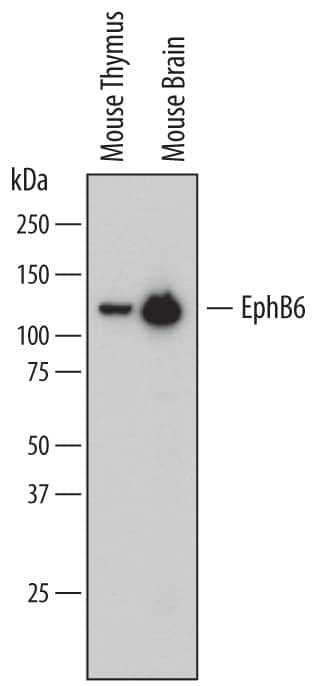Mouse EphB6 Biotinylated Antibody
R&D Systems, part of Bio-Techne | Catalog # BAF611


Key Product Details
Species Reactivity
Applications
Label
Antibody Source
Product Specifications
Immunogen
Leu33-Ser587
Accession # O08644
Specificity
Clonality
Host
Isotype
Scientific Data Images for Mouse EphB6 Biotinylated Antibody
Detection of Mouse EphB6 by Western Blot.
Western blot shows lysates of mouse thymus tissue and mouse brain tissue. PVDF membrane was probed with 1 µg/mL of Goat Anti-Mouse EphB6 Biotinylated Antigen Affinity-purified Polyclonal Antibody (Catalog # BAF611) followed by Streptavidin-HRP (Catalog # DY998). A specific band was detected for EphB6 at approximately 120 kDa (as indicated). This experiment was conducted under reducing conditions and using Immunoblot Buffer Group 1.Applications for Mouse EphB6 Biotinylated Antibody
Western Blot
Sample: Mouse thymus tissue and mouse brain tissue
Formulation, Preparation, and Storage
Purification
Reconstitution
Formulation
Shipping
Stability & Storage
- 12 months from date of receipt, -20 to -70 °C as supplied.
- 1 month, 2 to 8 °C under sterile conditions after reconstitution.
- 6 months, -20 to -70 °C under sterile conditions after reconstitution.
Background: EphB6
EphB6, also known as Mep (1), is a member of the Eph receptor family which binds members of the ephrin ligand family. There are two classes of receptors, designated A and B. Both the A and B class receptors have an extracellular region consisting of a globular domain, a cysteine-rich domain, and two fibronectin type III domains. This is followed by the transmembrane region and cytoplasmic region. The cytoplasmic region contains a juxtamembrane motif with two tyrosine residues, which are the major autophosphorylation sites, a kinase domain, and a conserved sterile alpha motif (SAM) in the carboxy tail which contains one conserved tyrosine residue. Activation of kinase activity occurs after ligand recognition and binding. However, it has been found that EphB6 contains substitutions within the kinase domain which results in EphB6 having no kinase activity (4). The ligands which bind EphB6 are unknown (2, 3). However, we have observed that the ephrin-B1 and ephrin-B2 ligands can bind the immobilized receptor in an ELISA-type assay. The extracellular domains of human and mouse EphB6 share 92% amino acid identity. Only membrane-bound or Fc-clustered ligands are capable of activating the receptor in vitro. While soluble monomeric ligands bind the receptor, they do not induce receptor autophosphorylation and activation (2). In vivo, the ligands and receptors display reciprocal expression (3). It has been found that nearly all receptors and ligands are expressed in developing and adult neural tissue (3). The Eph/ephrin families also appear to play a role in angiogenesis (3).
References
- Eph Nomenclature Committee [letter] (1997) Cell 90:403.
- Flanagan, J.G. and P. Vanderhaeghen (1998) Annu. Rev. Neurosci. 21:309.
- Pasquale, E.B. (1997) Curr. Opin. Cell Biol. 9:608.
- Gurniak, C.B. and L.J. Berg (1996) Oncogene 13:777.
Long Name
Alternate Names
Gene Symbol
UniProt
Additional EphB6 Products
Product Documents for Mouse EphB6 Biotinylated Antibody
Product Specific Notices for Mouse EphB6 Biotinylated Antibody
For research use only